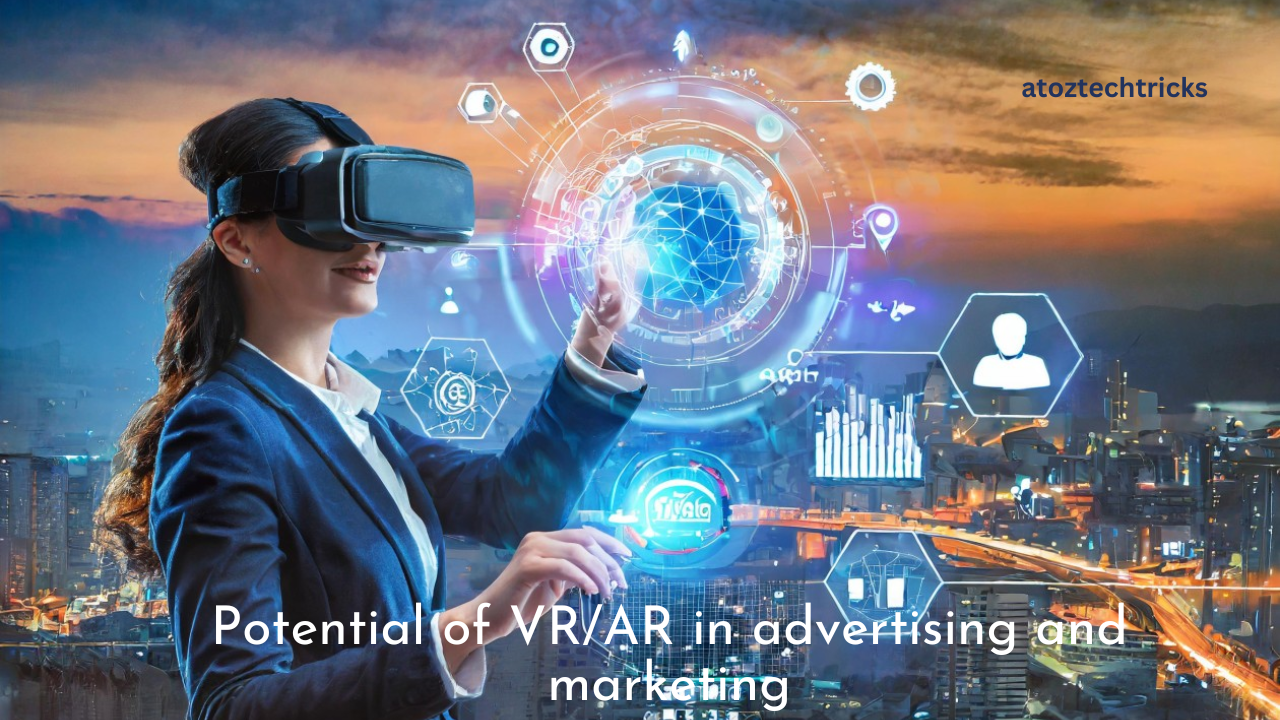The Potential of VR/AR in Advertising and Marketing
In recent years, Virtual Reality (VR) and Augmented Reality (AR) have moved from niche technologies to mainstream platforms with transformative potential. Initially popularized by gaming and entertainment, VR and AR are now revolutionizing advertising and marketing by offering immersive, interactive, and highly engaging experiences. This article explores how VR and AR are reshaping the advertising and marketing landscape, examining their applications, benefits, challenges, and prospects.
Understanding VR and AR
Virtual Reality (VR)
Virtual Reality immerses users in a fully digital environment, disconnecting them from the real world and placing them into a simulated experience. This is achieved through VR headsets or other devices that create a 360-degree digital environment. Users can interact with this environment in real-time, making VR a powerful tool for creating memorable and engaging brand experiences.
Augmented Reality (AR)
Augmented Reality, on the other hand, overlays digital information into the real world. This is typically achieved through mobile devices or AR glasses that project digital elements, such as images, videos, or animations, onto a live view of the physical world. AR enhances real-world interactions rather than creating an entirely new environment, making it an effective tool for integrating digital experiences with everyday life.
The Role of VR/AR in Advertising
Creating Immersive Experiences
One of the primary advantages of VR and AR in advertising is the ability to create highly immersive experiences. Traditional advertising often relies on static images or videos that may not fully capture the attention of consumers. In contrast, VR can transport users into a brand’s world, allowing them to experience products or services dynamically and interactively. For example, a travel company can use VR to provide virtual tours of exotic destinations, allowing potential customers to explore their vacation options from the comfort of their homes.
AR, on the other hand, can enhance physical products with interactive digital content. For instance, a furniture retailer can use AR to let customers visualize how a piece of furniture would look in their own homes before making a purchase. This level of engagement not only captures attention but also facilitates informed decision-making.
Enhancing Brand Engagement
VR and AR have the potential to significantly enhance brand engagement. By providing interactive and memorable experiences, brands can create a deeper emotional connection with their audience. For instance, a fashion brand might use AR to allow customers to virtually try on clothes, creating a personalized shopping experience that enhances customer satisfaction and increases the likelihood of purchase.
Moreover, VR experiences can be designed to be shareable, encouraging users to spread the word about the brand on social media. This user-generated content can amplify the reach of marketing campaigns and generate organic buzz around a brand.
Offering Personalized Experiences
Personalization is a key trend in modern marketing, and VR/AR technologies can take it to the next level. By leveraging data and user preferences, brands can create tailored experiences that resonate with individual consumers. For example, AR apps can use facial recognition to recommend beauty products based on a user’s skin tone, or VR experiences can adapt based on a user’s previous interactions with the brand.
Personalized experiences not only enhance customer satisfaction but also improve conversion rates. When consumers feel that a brand understands their unique needs and preferences, they are more likely to make a purchase and become loyal customers.

Case Studies: Successful Implementations
IKEA Place
IKEA’s AR app, IKEA Place, is a prime example of how AR can revolutionize the shopping experience. The app allows users to place virtual IKEA furniture in their own homes using their smartphone cameras. This interactive tool helps customers visualize how different pieces of furniture will look and fit in their spaces, making it easier to make informed purchasing decisions.
The app has been well-received for its ease of use and effectiveness in bridging the gap between online and offline shopping experiences. By enhancing the decision-making process and reducing the risk of returns, IKEA Place has demonstrated the significant impact AR can have on retail and advertising.
Nike’s VR Retail Experience
Nike has also leveraged VR technology to enhance its retail experience. The company has created virtual stores that allow customers to explore and interact with products in a fully immersive environment. These VR stores offer a range of features, including virtual try-ons and interactive product demonstrations, providing a unique and engaging way for customers to experience Nike’s products.
The success of Nike’s VR retail experience highlights the potential of VR to transform traditional shopping experiences, making them more interactive and personalized.
Benefits of VR/AR in Advertising
Increased Engagement
One of the most significant benefits of VR and AR in advertising is increased engagement. Traditional ads often struggle to capture and retain consumer attention, but VR and AR offer interactive and immersive experiences that naturally attract and hold attention. This heightened engagement leads to a greater likelihood of brand recall and positive association.
Improved Customer Experience
VR and AR technologies enhance the overall customer experience by providing more engaging and personalized interactions. Whether it’s virtually trying on clothes or exploring a product in a simulated environment, these technologies make it easier for customers to interact with brands and make informed purchasing decisions.
Enhanced Data Collection
VR and AR platforms provide valuable data on user interactions and behaviours. This data can be used to gain insights into consumer preferences, optimize marketing strategies, and improve the effectiveness of advertising campaigns. For example, tracking how users interact with virtual products can provide valuable information on product features that resonate most with consumers.

Challenges and Considerations
High Costs
Despite their potential, VR and AR technologies can be expensive to develop and implement. The costs associated with creating high-quality VR content or AR experiences can be a barrier for many brands, particularly smaller companies with limited budgets. Investing in these technologies requires careful consideration of the potential return on investment.
Technological Limitations
VR and AR technologies are still evolving, and there are technological limitations that can impact their effectiveness. For example, VR experiences require high-performance hardware and can sometimes cause motion sickness in users. AR experiences may be limited by the capabilities of users’ devices and the accuracy of tracking technologies.
Privacy Concerns
As with any technology that collects data, VR and AR raise privacy concerns. Users’ interactions and behaviours are tracked and analyzed, which can lead to concerns about data security and privacy. Brands must ensure they are transparent about data collection practices and comply with privacy regulations to maintain consumer trust.
Self-Care Practices for Emotional Well-Being: A Comprehensive Guide
Future Prospects
Integration with Artificial Intelligence
The integration of AI with VR and AR technologies holds significant promise for the future of advertising and marketing. AI can enhance VR/AR experiences by providing more personalized and adaptive interactions. For example, AI-driven virtual assistants can guide users through VR experiences or provide tailored recommendations based on user preferences and behaviours.
Expansion into New Markets
As VR and AR technologies continue to evolve, their applications in advertising and marketing are likely to expand into new markets and industries. For instance, the real estate sector could use VR to offer virtual property tours, while the automotive industry could use AR to provide interactive vehicle demonstrations.
Advances in Hardware
Advancements in VR and AR hardware are expected to make these technologies more accessible and affordable. As devices become more powerful and cost-effective, more brands will have the opportunity to leverage VR and AR for their advertising and marketing efforts. This increased accessibility will drive further innovation and adoption of these technologies.
The potential of VR and AR in advertising and marketing is vast and continues to grow as technology advances. By offering immersive and interactive experiences, these technologies have the power to transform how brands engage with consumers, enhance customer experiences, and drive business outcomes. While there are challenges to overcome, the benefits and opportunities presented by VR and AR make them valuable tools for the future of advertising and marketing. As technology continues to evolve, we can expect even more innovative and impactful applications of VR and AR in the advertising and marketing landscape.





Post Comment